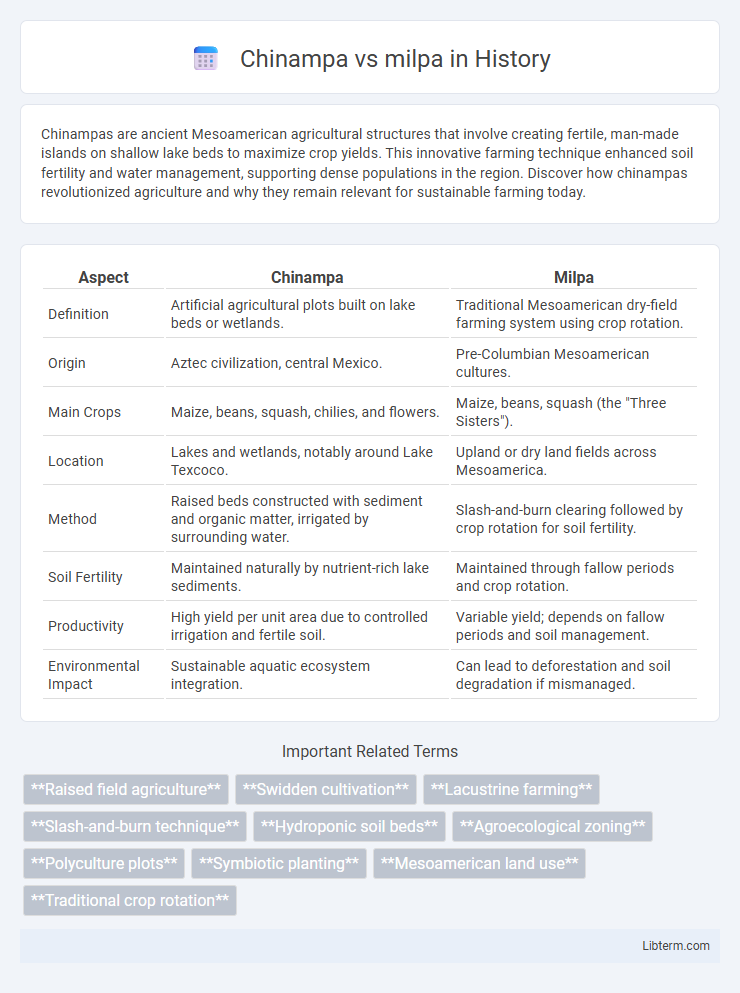Chinampas are ancient Mesoamerican agricultural structures that involve creating fertile, man-made islands on shallow lake beds to maximize crop yields. This innovative farming technique enhanced soil fertility and water management, supporting dense populations in the region. Discover how chinampas revolutionized agriculture and why they remain relevant for sustainable farming today.
Table of Comparison
| Aspect | Chinampa | Milpa |
|---|---|---|
| Definition | Artificial agricultural plots built on lake beds or wetlands. | Traditional Mesoamerican dry-field farming system using crop rotation. |
| Origin | Aztec civilization, central Mexico. | Pre-Columbian Mesoamerican cultures. |
| Main Crops | Maize, beans, squash, chilies, and flowers. | Maize, beans, squash (the "Three Sisters"). |
| Location | Lakes and wetlands, notably around Lake Texcoco. | Upland or dry land fields across Mesoamerica. |
| Method | Raised beds constructed with sediment and organic matter, irrigated by surrounding water. | Slash-and-burn clearing followed by crop rotation for soil fertility. |
| Soil Fertility | Maintained naturally by nutrient-rich lake sediments. | Maintained through fallow periods and crop rotation. |
| Productivity | High yield per unit area due to controlled irrigation and fertile soil. | Variable yield; depends on fallow periods and soil management. |
| Environmental Impact | Sustainable aquatic ecosystem integration. | Can lead to deforestation and soil degradation if mismanaged. |
Introduction to Chinampa and Milpa
Chinampa and milpa are traditional Mesoamerican agricultural systems developed to maximize crop production. Chinampa involves creating artificial islands on shallow lake beds for intensive cultivation, primarily used by the Aztecs around Lake Texcoco. Milpa refers to a shifting cultivation method that rotates maize, beans, and squash on a plot of land, widely practiced by indigenous groups throughout Mexico and Central America.
Historical Origins of Chinampa and Milpa
Chinampa agriculture originated in the ancient Lake Texcoco region of the Aztec civilization, utilizing raised, fertile plots on shallow lake beds for intensive crop cultivation. Milpa, a traditional Mesoamerican farming practice, dates back thousands of years and involves swidden or slash-and-burn agriculture primarily used by indigenous peoples in Mexico and Central America. Both methods reflect deep-rooted agricultural systems that sustained complex societies through diverse environmental adaptations.
Geographic Distribution and Environmental Context
Chinampas are traditionally found in the lacustrine environments of central Mexico, particularly around the Valley of Mexico, where shallow lakes and wetlands facilitate their construction and high agricultural productivity. Milpas, in contrast, are widespread across Mesoamerica, including elevated terrains and tropical lowlands, adapting to diverse environmental conditions with shifting cultivation techniques. The chinampa system thrives in stable, water-rich areas, while milpas rely on periodic forest clearing in more varied and often drier landscapes.
Core Principles of Chinampa Agriculture
Chinampa agriculture centers on constructing artificial islands in shallow lake beds using layers of mud, sediment, and vegetation, creating highly fertile, water-retentive soil ideal for intensive crop cultivation. This system promotes sustainable, year-round farming with efficient nutrient recycling and natural irrigation from surrounding water channels. Unlike milpa, which relies on rotating fields and slash-and-burn techniques, chinampas emphasize permanent plots that maximize land productivity through ecological engineering.
Core Principles of Milpa Agriculture
Milpa agriculture centers on the symbiotic cultivation of maize, beans, and squash, leveraging crop diversity to enhance soil fertility and reduce pest incidence. This polyculture system follows a cyclical pattern of planting, fallowing, and rotating fields to sustain long-term productivity and ecosystem balance. The core principle emphasizes maintaining ecological harmony through minimal intervention, promoting soil health, and supporting community subsistence needs.
Key Differences Between Chinampa and Milpa
Chinampa and milpa are both ancient agricultural systems used in Mesoamerica but differ significantly in structure and cultivation methods. Chinampa involves creating raised, fertile garden plots on shallow lake beds for intensive, year-round crop production, while milpa is a traditional swidden agriculture system relying on slash-and-burn techniques to cultivate maize, beans, and squash in upland fields. Key differences include water management in chinampas, enabling multiple harvests annually, contrasted with milpa's cyclical fallow periods that restore soil fertility naturally.
Crop Diversity and Agricultural Outputs
Chinampa agriculture, developed by the Aztecs, is characterized by high crop diversity with multiple layers of plants such as maize, beans, squash, and flowers grown simultaneously in nutrient-rich, water-surrounded plots, leading to increased agricultural output and year-round harvests. In contrast, the milpa system, prevalent in Mesoamerica, involves rotating the cultivation of maize, beans, and squash on upland fields with fallow periods, promoting soil fertility but typically resulting in seasonal outputs and lower overall productivity. The intensive, wetland-based chinampa system supports higher productivity and sustainable nutrient cycling, while the milpa emphasizes biodiversity and soil restoration through shifting cultivation.
Ecological and Environmental Impacts
Chinampas, ancient Mesoamerican raised-field agriculture systems, enhance biodiversity and water management by creating nutrient-rich, wetland environments that support diverse aquatic and terrestrial species. Milpas, traditional slash-and-burn fields, contribute to soil nutrient cycling but can lead to deforestation and soil erosion if not managed sustainably. Chinampas offer greater carbon sequestration and water conservation benefits compared to milpas, promoting long-term ecological balance and resilience.
Cultural Significance and Indigenous Knowledge
Chinampa and milpa agricultural systems reflect profound cultural significance and indigenous knowledge, with chinampas representing advanced Aztec engineering through floating gardens that maximized lake productivity and sustained urban populations. Milpa, a traditional Mesoamerican polyculture, embodies indigenous ecological wisdom by combining maize, beans, and squash to maintain soil fertility and biodiversity. Both systems demonstrate sustainable land management practices deeply rooted in ancestral traditions, supporting cultural identity and community resilience.
Modern Adaptations and Future Prospects
Chinampa and milpa agricultural systems are being modernized through integrated techniques such as permaculture and agroecology, enhancing sustainability and productivity. Innovations in water management for chinampas and crop diversification strategies for milpas address climate resilience and soil health challenges. Future prospects include scaling up these traditional methods with modern technology to support food security and ecological balance in Mexico and beyond.
Chinampa Infographic

 libterm.com
libterm.com